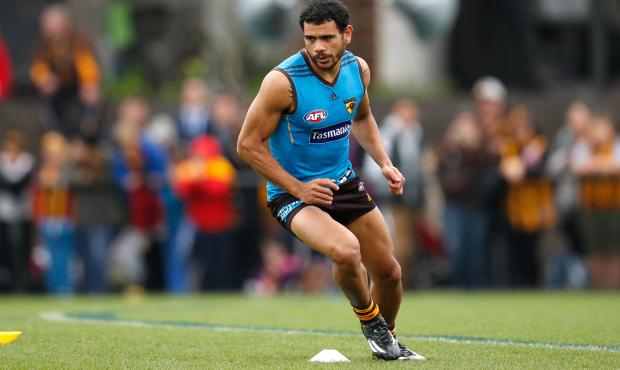Let the Sydney Swans win that battle and each Hawthorn defender will feel as though he's opened a kitchen cupboard and four saucepans have landed on his head.
To keep the Swans' peloton of forwards under control, Hawk defenders Josh Gibson (who averages 8.5 spoils a game), Brian Lake (the best intercept mark in the game), Matt Spangher (and probably Luke Hodge) need to support each other.
They can only do that if they get support from their midfield and forwards to slow the opposition down.
If that happens, Hawthorn can kick a winning score.
It scored 300 points more than the next best team in the home and away rounds.
It has kicked straight too, with an average accuracy better than 50 per cent.
It averages 55 inside 50s a game – just below the Swans’ average of 56.8 – and is brilliant at converting scores from stoppages, being No.1 in the competition for that statistic.
Hawthorn will make the most of its chances.
So what hope do the Hawks have of stopping the Swans’ midfield?
The most recent time the teams met – in round 18 – the Hawks dominated uncontested ball and handball receives.
However it wasn't the outside runners such as Brad Hill and Isaac Smith receiving handballs on that occasion.
It was Hodge (18 handball receives), Jordan Lewis (14) and Liam Shiels (14) who shared the ball in tight and stopped the Swans from gaining control in that area.
Sydney Swans star Dan Hannebery was missing that night, however, and his return will make a big difference to the Swans' work in tight.
Alongside Ben McGlynn – who creates pressure – Josh Kennedy, Jarrad McVeigh, Kieren Jack and Luke Parker are masters of their domain, not only capable of putting their head over the football but creating run with overlap handball.
Hawthorn is one of the few teams that can match the Swans inside and outside the contest, so it has a chance to break even.
Lance Franklin remains pivotal, with the Swans emptying out the forward 50 whenever they can to provide Buddy with space to roam.
In the past four games, the Swans have made Franklin the inside 50 target 39.2 per cent of the time. His late season form in the one-on-ones has been brilliant, winning more than 40 per cent of his man-on-man battles.
He is taking his marks too, his hands more like baseball gloves than cymbals in 2014.
Kurt Tippett pushes deep whenever Franklin hikes up the ground. He has been a target 20.9 per cent of the time.
The duo have kicked 40 goals between them since round 20. In that same time, Jarryd Roughead and Jack Gunston have kicked 32 goals between them.
Rarely do Hawthorn's key defenders follow Buddy when he works outside the 50, handing over the responsibility to a teammate up the ground.
Buddy can also run through stoppages, so Hawthorn will need a net on the defensive side of the stoppage.
If a defender tries to sit on him and chase him through, he might experience the same rough ride a bull rider has when the gate opens.
A defensive net suits the Swans, however, as they are good at flicking handballs out the back to extras in space behind the stoppage.
It keeps their metres gained from handballs low but the first handball is like a trickle of water at the top of a mountain that turns into a raging river at the bottom.
It's why Cyril Rioli's inclusion is so important.
The sneaking suspicion he might be lurking behind them at stoppages could worry the hard to stress Swans' midfielders. He can get also ahead of the ball in an instant.

If the ball falls to ground on Saturday, Hawthorn has Rioli, Paul Puopolo and Luke Breust to apply pressure on the Swans running defenders, Dane Rampe, Nick Malceski, Rhyce Shaw and Gary Rohan.
Hawthorn has applied an average of 12.8 tackles inside 50 in its past four games. It won't allow the Swans runners any time to weave their way out of defence.
If the Hawks don't apply necessary pressure they will pay, as the Swans have averaged 6227 metres gained per game in the past four games.
The Swans’ running defenders like to attack through the middle, or make lightning switches to the fat side to move the ball from defence to attack.
Hawthorn likes to spread their opponents, making the ground wide and moving it around the fence line if it needs to.
The teams do have some unique characteristics but by and large their game is based on a fundamental: win the contest.
Amid all the dross that flies around in Grand Final week, whoever does that more often than the opposition will win.
Appreciate the fact that the Swans lead the competition in contested possessions and tackles while the Hawks are clearance specialists and use the ball well and then forget it.
Because on Saturday when the ball is bounced, two teams, who share the same number of average games (136 apiece) are likely to enter a battle for the ages.


